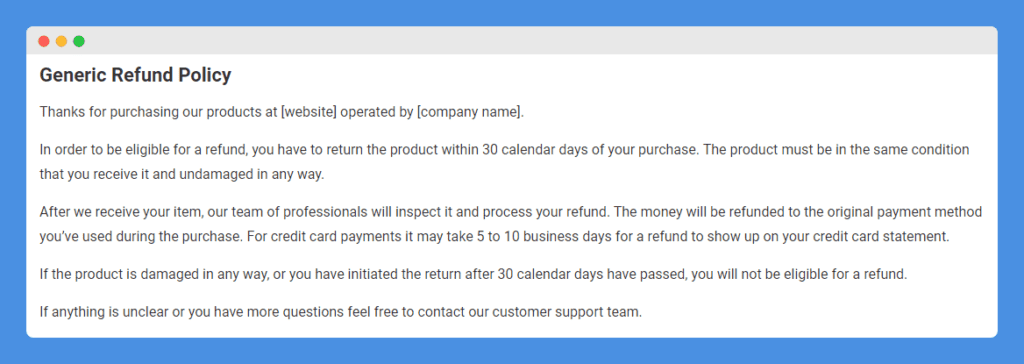A refund and return policy is a set of guidelines that outlines what happens if a customer needs to send something back. It covers things like refunds, timelines, and return conditions.
Having a clear and customer-friendly policy not only boosts your business’ reputation but also helps increase sales. The problem? Many online stores either lack a policy entirely or have one buried in legalese, leaving customers frustrated and hesitant to buy.
To make sure your store doesn’t meet the same fate, I’ll provide a comprehensive return and refund policy template as a starting point, unpack the key elements a good policy should have, and show you how to make it easily accessible to your customers.
I’ll also share real-world examples from successful online stores to show you how to turn a clear return and refund policy into a customer-winning strategy!
- Your return policy is a key part of your online store. Make it clear and easy to find so customers know what to expect if they need to refund or return products.
- Use a return and refund policy generator to get a head start and then tailor it to your store’s needs. A good one ensures you cover the essentials while also saving you time.
- There are many places to display your return policy. A dedicated page is a good option, but you should also include it in the footer, checkout page, and anywhere else it might be relevant.
Table of Contents
PRO TIP: Take the hassle of writing your own refund policy away with our refund policy generator trusted by over 200,000 businesses. It’ll save you hours of work and help increase sales in minutes.
Free Refund and Return Policy Template for Websites
A key element to boosting customer satisfaction is a clear return process. The following template provides a solid foundation you can customize to fit your specific store and products:
Refund Policy Template for Digital Products
Refund Policy Template for Physical Products
Refund Policy Template for Perishable Products
A Better Way To Create a Refund and Return Policy To Increase Your Sales
While the provided template is a great starting point, you might be short on time or simply prefer a faster and easier solution. This is where our refund and return policy generator comes in handy.
Using this tool means you won’t have to waste time and effort learning how to write a return policy. In just three simple steps, you can publish your store’s return or exchange policy.
What’s more, all policies generated are curated by our team of legal experts to make sure they’re legally sound. In case of changes and updates in consumer protection laws, we’ll notify you immediately so your policy stays compliant at all times.
12 Essential Details to Include in Your Refund and Return Policy
Crafting an effective refund and return policy is key to ensuring customers feel secure when they shop with you. But what exactly should your policy cover?
To help your customers know their rights and responsibilities should they need to return a purchased item, it’s important to clearly outline what is required to get a refund or exchange.
Below are 12 essential details that should be included in your policy to make this process as smooth as possible:
1. Overview of the Policy
Consider the overview as the introduction of your return and refund policy. It sets the tone and gives customers a quick understanding of your overall approach to returns and exchanges.
Mention if you offer free shipping on returns, how long they have to return the product, and under what circumstances. Keep this section concise and positive, though. The goal is to assure customers you have a fair and hassle-free return process.
A customer-centric overview can go a long way in reducing purchase anxiety and encouraging customers to complete their purchases with confidence.
2. Refund Information
This section dives deeper into the specifics of how customers will receive a refund if they return an item. Here, you’ll want to outline whether you offer full or partial refunds under different circumstances.
For example, will you provide a full refund for unworn items with tags, but only a partial refund for worn or damaged items? It’s also important to specify how long it typically takes for customers to see the refund reflected in their account after they return an item.
Transparency is key here! By outlining the refund details clearly, you set expectations and ensure a smooth process for you and your customers.
3. Timeline for Refunds
A clear return policy hinges on a well-defined timeline for refunds. So, in this section, be as straightforward as possible when discussing the timeframe within which customers can return an item.
Will you offer a full refund within 30 days of purchase, or do you have a shorter window? Some stores offer an even longer return window, giving customers up to 60 days to return the item.
The key is striking a balance between a reasonable timeline for refunds and protecting your business from fraudulent returns.
4. Condition of Returned Items
Be clear about the condition in which customers can return a product to receive a refund or exchange. Typically, stores will only accept returns for items that are unworn, unwashed, and have their original tags attached.
However, you can customize this section to fit your specific products and business needs. For example, an accessory store might be more flexible with slightly used items, while a clothing store might require stricter criteria.
Also, address situations where customers have different reasons for the return beyond its condition (e.g., wrong size, wrong color). Specifying if these situations are also covered will help manage customer expectations and ensure a smooth return process.
5. Return Process Steps
Provide clear, step-by-step instructions on how to return an item. This typically begins with the customer contacting your support team to express their desire to return a product and stating the reason.
Next, they should be instructed on how to obtain a return shipping label, often provided via email or downloadable from your website. Ensure the steps include packaging the item securely. Finally, advise the customer where to drop off the package for shipping.
PRO TIP: Be clear and concise. The more detailed your instructions are, the easier you can ensure a smooth return experience for both the customer and your business.
6. Shipping Costs
State whether your business will shoulder the return shipping cost, or if customers are responsible for it. If you don’t offer free returns, be clear about the cost structure. Will customers be responsible for the full return shipping cost, or will you split it?
However, if you do offer them free of charge, you can use that to your advantage to attract more customers. According to a 2022 survey, 63% or about two-thirds of U.S. shoppers prefer buying from a store with free returns!
7. Exchange Policy
Here, you’ll specify whether customers are entitled to a refund or just an exchange for items that meet your return criteria (e.g., unworn, with tags). But you have to be clear about any limitations on exchanges.
For example, will you only allow exchanges for items in the same price range? Do they need to exchange the item within the same return window timeframe?
Outlining your exchange policy gives customers flexibility and encourages them to choose your store, knowing they can easily swap an item. Remember, a happy customer with the right product is more likely to come back for future purchases!
8. Restocking Fees
Restocking fees are essentially a charge applied to returned items to cover the cost of restocking the item in your inventory. While not all stores implement them, it’s important to be upfront about any such fees associated with returns.
Specify under what circumstances it applies (e.g., a percentage of the original purchase price for certain items only). Also, be transparent about when it is deducted. Is it taken out of the original purchase price before customers receive the refund?
PRO TIP: If you don’t charge restocking fees, be sure to mention that! Highlighting this can be a selling point and encourage more purchases.
9. Non-Returnable Items
Some items may be excluded from your general return policy due to hygiene concerns, safety regulations, or other factors. In this section, you may want to list any items that cannot be returned or exchanged. This could include:
- Personal care items: Unopened cosmetics, toiletries, and fragrances are common examples, as hygiene is a major concern.
- Underwear and swimwear: Due to hygiene reasons, many stores don’t accept returns on these items.
- Downloadable products: Digital products like ebooks or software licenses often can’t be returned once downloaded.
- Perishable items: Food and flowers typically can’t be returned due to their perishable nature.
- Custom-made items: Items personalized or custom-made for a customer may not be eligible for returns.
Be sure to explain the reasoning behind excluding certain items. This helps manage customer expectations and prevents any confusion about what can and can’t be returned.
10. Required Documentation
Outline what customers need to provide to request a refund successfully. Typically, this includes the original receipt, an order confirmation email, or any proof of purchase that verifies the transaction.
Let your customers know that you may not be able to give a refund without these documents, as they help verify the purchase and protect against fraud.
Clearly specify which documents are needed and any acceptable formats (e.g., digital or paper). Providing this information upfront ensures that customers are prepared with the necessary documentation, which then streamlines the return process.
PRO TIP: Consider offering some flexibility. For example, if a customer can’t locate their receipt, you might be able to process the return based on their order history or email address.
11. Contact Information
This section instructs customers on how and where to contact customer service for returns. A good return policy also emphasizes the availability and responsiveness of your support team.
Provide clear and accessible contact details, such as a dedicated phone number, email address, or even a chat option. This ensures that customers can reach out with ease regarding returns or any other concerns.
Even with a well-written policy, some customers might have questions or require additional guidance. Make it easy for them to reach out to your customer service team for assistance.
12. Dispute Resolution
This section should address how disputes related to a return, refund, and even a cancellation are managed.
You’ll want to outline the steps a customer should take if they are dissatisfied or if there’s a disagreement. Then, detail how your business will work to resolve these issues efficiently and fairly.
To show the importance of having a proactive approach to resolving customer issues, founder and former CEO of The Ritz-Carlton and Four Seasons Hotels, Isadore Sharp, said in an interview with Mike May,
“The #1 goal of excellent customer service is anticipating needs and even unexpressed wishes – and then delivering that service with personalized perfection.”
Incorporating such customer-centric practices into dispute resolution can significantly enhance trust and satisfaction, turning potentially negative experiences into positive ones.
How To Create a Return and Refund Policy
Knowing the essential details to include in your return and refund policy ensures it is informative, transparent, and customer-friendly. But how do you actually translate all this knowledge into a policy for your website?
Here are several routes you can take:
- Free Return and Refund Policy Generator: This is the easiest and most practical solution for many. These online tools guide you through the process, helping you create a policy customized to your store’s needs.
- Return Policy Template: Many websites offer free return policy templates you can download and adapt to your store. While a template provides a solid foundation, it requires some tweaking to perfectly align with your specific policies (e.g., return window, restocking fees).
- Hiring a Lawyer: For the most comprehensive and legally airtight policy, consider consulting with a lawyer specializing in eCommerce. This option is ideal for businesses with complex return needs or those in highly regulated industries. However, it’s also the most expensive option.
If you ask me, using a return and refund policy generator or template is the most practical and time-efficient way to create a customer-friendly policy that matches your unique business needs.
Do’s and Don’ts When Creating Your Return and Refund Policy
Before you write and post a refund policy, it’s important to consider the best practices that should be followed and the pitfalls that need to be avoided.
The following dos and don’ts will guide you in creating a well-written return policy for your store that is fair, clear, and effective:
Do’s
- Ensure Clarity and Simplicity: Make sure your policy is easy to understand and avoids complex legal jargon.
- Be Transparent about Timelines and Processes: Clearly state the time frames for returns and exactly how customers can initiate a return.
- Specify Conditions for Eligibility: Detail what makes a product eligible for a return or exchange, including the condition of the item upon return.
- Offer Multiple Return Options: Provide a refund, exchange, or store credit to cater to different customer needs.
Don’ts
- Overcomplicate the Process: Avoid creating a policy that is too restrictive or difficult to follow, which can deter customers from making purchases.
- Ignore Legal Requirements: Ensure your policy complies with local and international consumer protection laws.
- Be Inflexible: While it’s important to have clear rules, consider case-by-case flexibility to accommodate unique circumstances.
- Hide Your Policy: Do not bury your return policy in hard-to-find sections of your website; make it easily accessible.
Where to Display a Return and Refund Policy on Your Website
According to a 2022 survey of U.S. consumers, 31 percent of respondents cited difficult-to-find return policies as the second-most common reason they were discouraged from shopping online.
This statistic underscores the importance of where you choose to display a return policy on your website. Here are the most practical and effective spots:
Dedicated Page
Create a dedicated page solely for your return and refund policy. This makes it a central hub where customers can find all the necessary information about returns and refunds.
Let’s take a look at how Alo Yoga, a popular online store known for its stylish and functional yoga apparel, leverages a dedicated return and refund policy page:
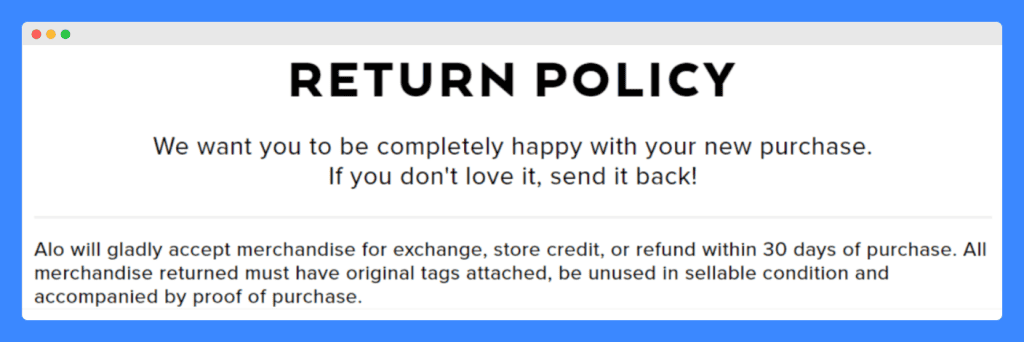
With an entire webpage specifically for their return and refund policy, Alo Yoga creates a central hub where customers can find all the information they need in one convenient location. This eliminates the need to search through various sections of the website.
Website Footer
It’s standard practice to display your return policy in the footer of your website. This ensures the policy is accessible from any page, providing constant visibility.
UNTUCKit, a popular retailer known for its comfortable and stylish dress shirts, also displays its return policy in the footer of its website.

This placement strategy ensures that the policy is universally accessible from any webpage, regardless of where a customer is browsing.
Checkout Page
Including a link to your return policy on the checkout page is vital. It reassures customers about their ability to return items right before they complete their purchase. Here is BLACKTAILOR’s checkout page as an example:
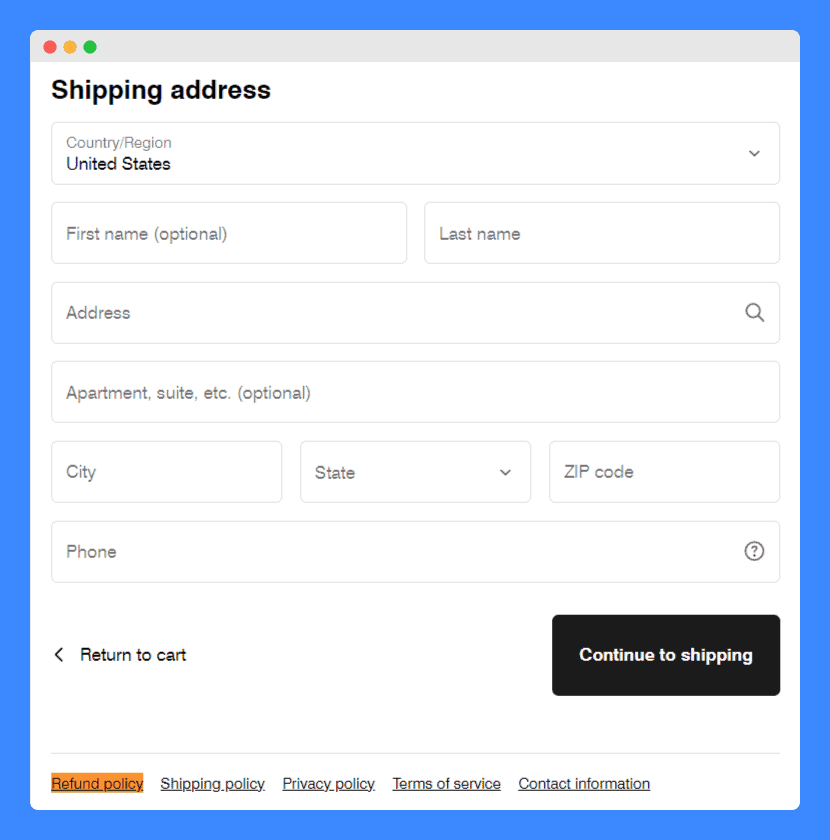
This strategic placement is crucial, as it provides last-minute reassurance to customers about their ability to return items. This can be particularly significant for an apparel brand where fit and satisfaction may vary.
FAQ Section
Adding your return policy to an FAQ section helps address common customer questions and concerns about returns, directly linking to the detailed policy page for more information.
Let’s see how William Painter, a store known for its lifetime warranty sunglasses, incorporates their return policy into their FAQ section:
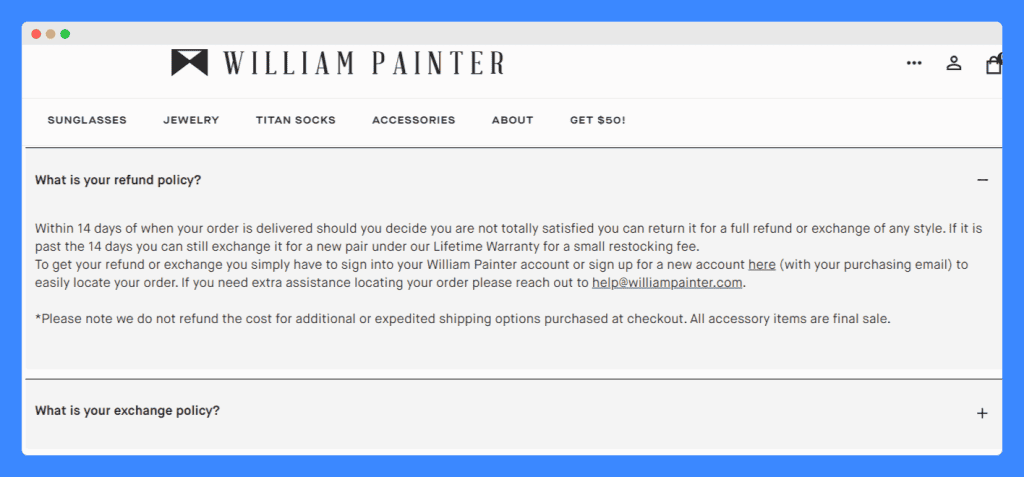
Doing this allows William Painter to address common customer concerns head-on and provide a brief overview of their policy. Such transparency ensures that potential buyers feel more secure and informed, likely increasing their willingness to make a purchase.
Product Pages
Display a brief summary or a direct link to your return policy on each product page. This informs customers about the return terms before they decide to purchase.
Allbirds, known for its eco-friendly shoes, includes a direct link to its return policy on each product page:

This helps decrease the likelihood of returns due to misinformed purchase decisions, thereby maintaining customer satisfaction and loyalty.
Customer Service Page
Incorporating your return policy into your customer service page is a great strategy, as it places the policy in a context where customers are already seeking help.
Outdoor Voices includes its return and exchange policy within its Help Center, a section of its website dedicated to customer support:

This placement allows customers to quickly access clear and comprehensive information about returns while they are actively seeking assistance.
PRO TIP: Adding a link to your return and refund policy in your privacy policy is also a good idea. It reinforces transparency and provides another avenue for customers to access the policy, ensuring they feel secure and informed at every step.
How Often Should You Update Your Return and Refund Policy?
Review and update your return and refund policy at least annually or whenever there are significant changes to your operations. This way, you ensure it continues to meet the needs of your business and your customers.
Here are some tips for effectively updating your return and refund policy:
- Monitor Changes in Consumer Law: Keep abreast of any changes in local, state, or federal consumer protection laws that might affect your return practices. Then, ensure your policy complies with these regulations.
- Reflect Business Changes: Update your policy to reflect any changes in your business model. This may include new product lines or changes in your fulfillment process that might impact how you manage returns.
- Consider Customer Feedback: Regularly review customer feedback regarding returns and refunds. If you notice patterns of confusion or dissatisfaction, consider revising your policy to address these issues.
- Check Competitor Policies: Keep an eye on the return policies of competitors. If they offer more favorable terms, you might want to adjust your policy to stay competitive.
Set a regular schedule for reviewing your return policy. This is also a good time to reassess the value of your return policy in maintaining customer trust and satisfaction.
Great Return and Refund Policy Examples You Can Learn From
A great return and refund policy doesn’t just comply with the law. It enhances customer experience and serves as a competitive advantage.
Here are some standout return and refund policies that have set the standard in various industries, demonstrating best practices you can adapt and implement in your business:
1. Red Dress
Let’s take a look at Red Dress, a retailer known for its special occasion dresses. Their return and exchange policy is a great example of clear communication and customer-centric options.

The policy is concise yet informative, outlining the difference between exchanges and returns, and clearly stating any associated fees. They even go the extra mile by providing a direct link to their Returns page, making it easy for customers to request a return.
Red Dress enhances its return policy by partnering with Happy Returns, providing a quick, easy, and environmentally sustainable option for in-person returns.
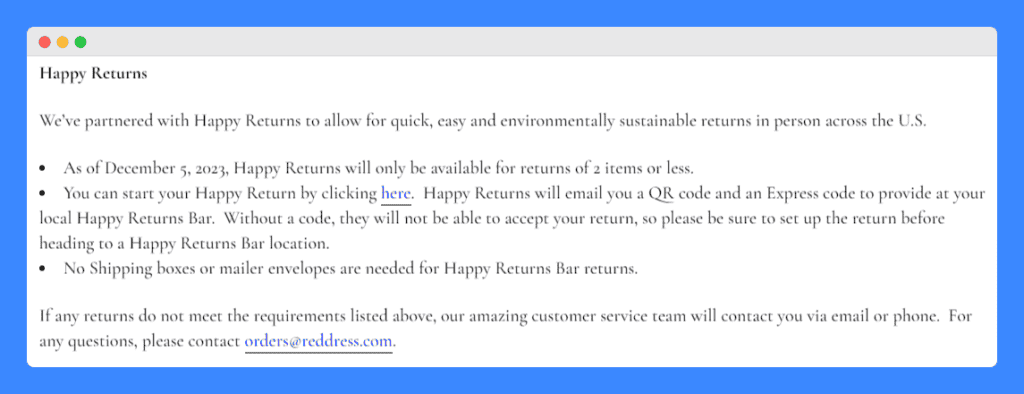
This return policy is clearly designed to be customer-centric, as it eliminates the need for shipping materials, making the process more convenient and eco-friendly.
Additionally, the requirement for a pre-arranged QR code ensures a streamlined and efficient return experience at any Happy Returns Bar location. This further demonstrates a commitment to both simplicity and environmental sustainability.
2. Jeffree Star Cosmetics
Jeffree Star Cosmetics, a popular makeup brand known for its high-quality products, also offers a clear and concise return policy. This snippet from their policy is a great example of straightforward communication:

Their return and refund clearly states that their customers only have 14 days for a refund and that they currently don’t offer exchanges. By keeping it simple and to the point, they ensure customers understand the key details of the return process upfront.
Moreover, the policy’s transparency about the refund process, including the method and timing of refunds, reassures customers of a smooth and reliable transaction.

Jeffree Star Cosmetics also acknowledges potential delays by banking institutions and the option for a refund by check for customers with inactive accounts. This avoids confusion and keeps customers informed throughout the return process.
3. mnml
Here’s another well-written return and refund policy sample from mnml, a clothing brand focused on minimalist apparel:
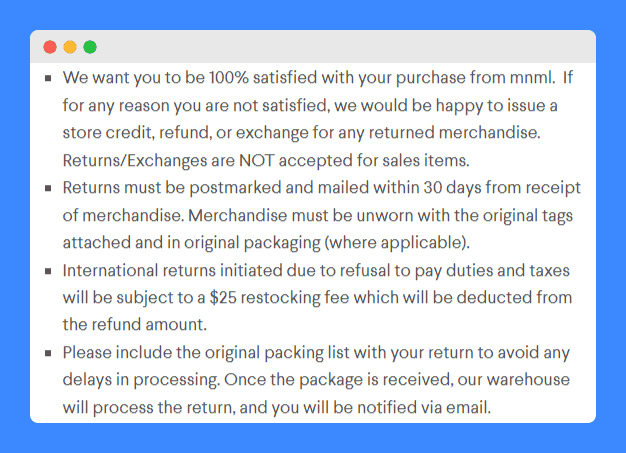
The use of bullet points is a great practice here as it creates a scannable and visually organized format. This makes it simple for customers to quickly grasp key details, such as the return window, return conditions, and restocking fees (if applicable).
4. Kith
Kith, a renowned streetwear brand, provides a standard return policy example that outlines a clear and efficient return process:
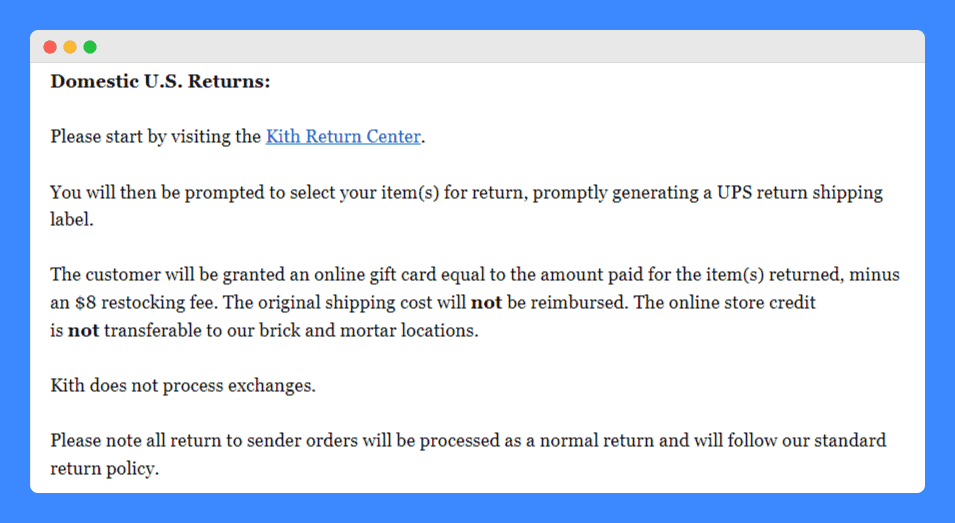
Including the link to their Return Center streamlines the return process, making it convenient for customers to initiate returns.
Plus, the policy’s transparency about the restocking fee and non-reimbursement of original shipping costs sets clear expectations, helping avoid misunderstandings.
5. The Yetee
The Yetee is an online retailer known for its limited-edition products, making its return policy crucial to protect its business.

By specifying the conditions for returns, such as the requirement for garments to be unworn and unwashed, The Yetee’s comprehensive return policy allows them to prevent abuse of their return system.
This attention to detail not only protects their business but also ensures customer satisfaction by addressing potential issues promptly and fairly.
Frequently Asked Questions
Who needs a return and refund policy?
Any business selling products, especially eCommerce stores, needs a return and refund policy. This document outlines the terms and conditions of returning or exchanging items.
Why do you need a return and refund policy?
A return and refund policy ensures customer satisfaction, builds trust, and reduces disputes. This policy also protects businesses by setting clear guidelines for returns and exchanges.
Can you use a return and refund policy template?
Yes, using a template to create a refund and return policy can help businesses ensure they include all necessary information and format it correctly. This saves time and ensures clarity for customers.
Can you copy a return and refund policy from another website?
No, it’s not advisable to copy a return and refund policy from another website. Each business has unique needs and copying could lead to legal issues.
Are return and refund policies legally required?
No, businesses are not legally required to have a return and refund policy. However, having one can protect both the business and the customer.
What is the difference between a refund and a return?
A return involves sending back an item for a refund, exchange, or store credit. A refund is the actual reimbursement of the purchase price.
Why is a “money-back guarantee” policy usually good for businesses?
A “money-back guarantee” policy for your company is good for business because it can boost customer confidence, increase sales, and differentiate your store from competitors.
Why is a “no refunds” policy usually bad for business?
A “no refunds” policy can deter customers, harm your reputation, and lead to negative reviews. It may result in lost sales and customer loyalty.

